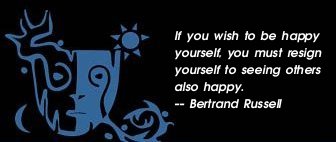|

Men, Women, and Rats in the Moon
by Brenda Sutton
[Image: "Oriental Rat in the Moon"
Pictorial Arts of Japan — Part II & III
published by Sampson Low, Marston, Searle & Rivington]
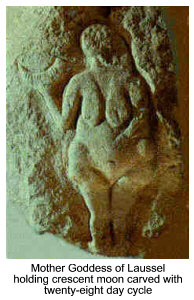 Human beings look to the night sky and find faces in the moon. We know it is just a huge hunk of meteor-pocked rock, only visible to us because of reflected light. Its waxing and waning crescents appear when our world comes between it and the sun. We know this fact. We've sent astronauts to confirm the dusty truth that there is no green cheese up there in the sky. Still...our quirky human nature anthropomorphizes that which we don't fully understand, finding facial features in the Sea of Tranquility. Human beings look to the night sky and find faces in the moon. We know it is just a huge hunk of meteor-pocked rock, only visible to us because of reflected light. Its waxing and waning crescents appear when our world comes between it and the sun. We know this fact. We've sent astronauts to confirm the dusty truth that there is no green cheese up there in the sky. Still...our quirky human nature anthropomorphizes that which we don't fully understand, finding facial features in the Sea of Tranquility.
As a Wiccan, the moon holds a place of reverence in my spiritual practice. It symbolizes the great Mother Goddess and Her round and shining feminine form. Women from the dawn of time have felt the pull of the moon in the tides of the oceans and the tides of our bodies. Stone Age artists from Laussel, France carved Her voluptuous outline in bas relief. Just ask any woman what that crescent moon represents, with its twenty-eight hatch marks, upheld in Her hand. It's us, our lives, our bloody inner clockwork ticking out fertility, tocking out the waters of the womb. We made that connection eons ago, and it remains ingrained in the psyche as long as the moon continues to rise.
But not everyone sees the moon as feminine. The elves and hobbits who inhabit J.R.R. Tolkien's Middle Earth viewed the sun as feminine and the moon as masculine. He described the Man in the Moon on several occasions in great detail. Read the poem "The Man in the Moon Came Down Too Soon":
The Man in the Moon had silver shoon
And his beard was of silver thread;
He was girt with pure gold and inaureoled
With gold about his head.
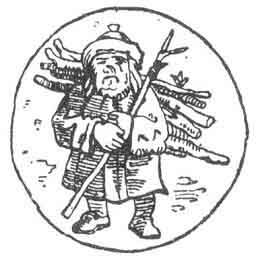 Many European legends depict the man in the moon as an old fellow hauling a bundle of willow sticks upon his back (formed from the craters of the moon called Mare Serenitatis, Tranquilitatis and Foecunditatis). He carries a lantern on a forked stick (the crater Tycho), and he is accompanied by a little dog (Mare Crisium). Shakespeare used this description in Act Five of A Midsummer Night's Dream. The actor playing Moonshine in the bumpkins' performance of Pyramus and Thisbe is costumed exactly so. Many European legends depict the man in the moon as an old fellow hauling a bundle of willow sticks upon his back (formed from the craters of the moon called Mare Serenitatis, Tranquilitatis and Foecunditatis). He carries a lantern on a forked stick (the crater Tycho), and he is accompanied by a little dog (Mare Crisium). Shakespeare used this description in Act Five of A Midsummer Night's Dream. The actor playing Moonshine in the bumpkins' performance of Pyramus and Thisbe is costumed exactly so.
MOONSHINE: This lanthorn doth the horned moon present;
Myself the man i' the moon do seem to be...
All that I have to say, is, to tell you that the
lanthorn is the moon; I, the man in the moon; this
thorn-bush, my thorn-bush; and this dog, my dog.
And in The Tempest, Shakespeare repeatedly calls Caliban a moon calf, mentioning the man in the moon in a scene between Caliban and Stephano:
CALIBAN: Hast though not dropped from heaven?
STEPHANO: Out of the moon I do assure thee: I was the man i' the moon when time was.
CALIBAN: I have seen thee in her, and I do adore thee: My mistress showed me thee and thy dog and thy bush.
 People have developed some pretty interesting ideas to explain how the man in the moon actually got to live on his far-flung home. He climbs a rope or a ladder to polish the stars. He flies there on a magic carpet. Some say that his outline stands as a warning from the time when Moses condemned a man for gathering firewood on the Sabbath. While, in a German version of the story, we are told about an old man who met a similar fate: People have developed some pretty interesting ideas to explain how the man in the moon actually got to live on his far-flung home. He climbs a rope or a ladder to polish the stars. He flies there on a magic carpet. Some say that his outline stands as a warning from the time when Moses condemned a man for gathering firewood on the Sabbath. While, in a German version of the story, we are told about an old man who met a similar fate:
An old woodcutter went out of a Sunday morning to cut a faggot of wood to warm his chilly hut. After all his hard work, he slung the bundle over his shoulder and started the long, cold walk back to his home. He spied a good looking young fellow all dressed up in fine church clothes coming towards him along the lane. As they passed each other, this pious young dapper chided him for working on the Lord's day.
"Sunday on earth, or Monday in heaven, it's all the same to me!" laughed the woodcutter.
"Since you do not value your rest on Sunday, you shall labor in heaven on an endless Moonday!" cursed the young man, who was really an angel in disguise. The old woodcutter was shipped off to work forever on the cold, lonely, treeless moon — stiff punishment for trying to keep warm in winter.
Celtic traditions teach that the dark side of the moon is one of the hidden locations of the western island of Tir na Nog, the Land of the Ever Young. It's so far west as to be off the borders of all maps and charts, a place where the sea ends and the heavens begin. This is the otherworld where spirits go at death to live in beauty and abundance while awaiting rebirth.
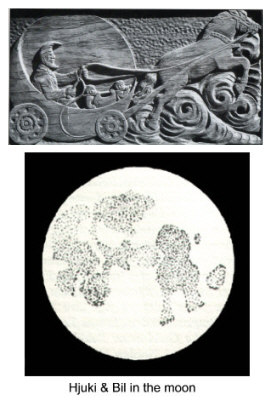 There is an old Norse legend that tells how the moon god, Mani, kidnapped two young children, Hjuki (creation) and Bil (destruction), and forced them to draw water from the well Byrgir, very similar to the nursery rhyme of Jack and Jill who 'went up a hill to fetch a pail of water'. Those same Norse believe that one may find an endless supply of mead on the moon, so perhaps our hapless woodcutter spends eternity tipsey. In 1885, the Reverend Timothy Harely published a monograph on Moon Lore with many well-known myths about the place and its inhabitants. According to the reverend, the man in the moon is definitely not Tea Total. Oh, no, he favors dark wine, which accounts for the occasional hazy red ring around our satelite. There is an old Norse legend that tells how the moon god, Mani, kidnapped two young children, Hjuki (creation) and Bil (destruction), and forced them to draw water from the well Byrgir, very similar to the nursery rhyme of Jack and Jill who 'went up a hill to fetch a pail of water'. Those same Norse believe that one may find an endless supply of mead on the moon, so perhaps our hapless woodcutter spends eternity tipsey. In 1885, the Reverend Timothy Harely published a monograph on Moon Lore with many well-known myths about the place and its inhabitants. According to the reverend, the man in the moon is definitely not Tea Total. Oh, no, he favors dark wine, which accounts for the occasional hazy red ring around our satelite.
"Our man in the moon drinks clarret,
With powder-beef, turnep, and carret.
If he doth so, why should not you
Drink until the sky looks blew?
"The man in the moon drinks claret,
But he is a dull Jack-a-Dandy;
Would he know a sheep's head from a carrot,
He should learn to drink cyder and brandy."
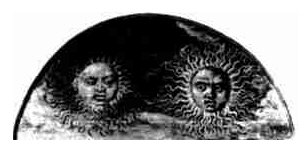
In northern India, the creation legend of the Minyong people tells of twin sisters — Bomong, the moon, and Bong, the sun — born of the lovers, earth and sky. A wise woman raised the beautiful girls, teaching them well until they grew into powerful and exemplary young women. The twins were inseparable. Together they were so strong and brilliant that, when they crossed the heavens, their combined light and heat parched the land. All of the creatures of the world suffered. Plants whithered under their perpetual radiance. Oceans evaporated leaving fish flopping about in wallows of mud. Soon everything on earth would perish.
And so the creatures of earth plotted to murder one of the twins, but no one wanted to be the one to actually do the dirty deed. Finally, however, Frog volunteered to attempt the task. He took his bow and arrows, and hopped up to the sisters' home in the heavens. There he lay in wait under a lily pad for the first sister to stumble into his sight.
After a few hours, Frog heard footsteps coming up the path. He notched his arrow and drew his bow taut. A radiant figure came into view. "I'm sorry," croaked Frog as he loosed his arrow and let it fly — straight into the heart of Bong, the sun. She died in the arms of her sister, and her light died with her. In this lesser light, the world was no longer trapped in heat. Plants began once more to sprout leaves. Rivers once more flowed into the sea. The creatures of earth rejoiced.
But Bomong did not rejoice. She grieved for the death of her sister, and worried that the creatures of earth might try to kill her, too. So she hid herself in a very dark cave, under a very large rock.
All light was extinguished. In darkness, the plants no longer thrived, but lost their green color and faded to white. The creatures of the earth feared for their lives once again, and thought that perhaps they acted hastily by murdering Bong. They searched high and low for Bomong, calling out for her, "Come out, come out! Shine for us!"
Cockerel flew over the dark land until he spotted a dim light peeping out from a crack in the cave wall, and discovered Bomong weeping for her sister. Try as he may to console her, Cockerel couldn't persuade her to return to the heavens. He left the cave with a message for the creatures of earth: they must find some way to resurrect Bong.
So a carpenter set about to rebuild Bong. He went first to the wise woman who had raised the girls, and he asked her to tell him stories about Bong. Watching the nurse's face, he could see Bong's light shining in the old woman's eyes. From this memory, he was able to craft a smaller, though not so brilliant, version of her, which he placed far in the heavens to the great joy of Bomong. The twins return home at each eclipse. To this day, the frogs hide away, singing their nightly apologies, and the cocks crow at the first sight of light peeping over the horizon. "Come out, come out! Shine for us!"
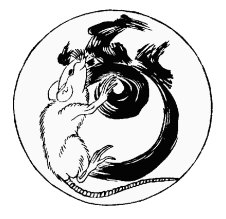 In addition to many people living on the moon, there is a wilderness full of animals: bears, lions, rabbits, fish, snakes, rats, cats and more. In Malaysia they tell the story of an old hunchback with a cat who resides on the moon. They sit underneath an upsidedown banyan tree, while the old man patiently plaits the tree's bark into fishing line. "Once I have enough line, I'll fish until I catch everything on earth." In addition to many people living on the moon, there is a wilderness full of animals: bears, lions, rabbits, fish, snakes, rats, cats and more. In Malaysia they tell the story of an old hunchback with a cat who resides on the moon. They sit underneath an upsidedown banyan tree, while the old man patiently plaits the tree's bark into fishing line. "Once I have enough line, I'll fish until I catch everything on earth."
Fortunately for us, there is also a rat in this legend who busily gnaws through the completed line. Unfortunately for us, the hunchback's cat often chases the rat away, allowing the fisherman to nearly complete his task. So long as all three of them — the hunchback, the rat, and the cat — do their work, we remain safe here on earth. If the cat catches the rat, and the rat isn't there to gnaw the rope, the hunchback will finish his fishing line, and the world will end. Pray for balance.
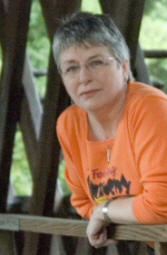 Brenda Sutton is the publisher of Mythic Passages, Operations Director, Corporate Secretary, and Office Administrator for Mythic Imagination Institute. She is an award-winning singer/songwriter with the internationally reknown band Three Weird Sisters. She works in a support and consultant capacity for the non-profit music organization Interfilk, and maintains their website. She is freelance writer whose work has appeared in newspapers and magazines. She is also the mother of five, grandmother of two.
Brenda Sutton is the publisher of Mythic Passages, Operations Director, Corporate Secretary, and Office Administrator for Mythic Imagination Institute. She is an award-winning singer/songwriter with the internationally reknown band Three Weird Sisters. She works in a support and consultant capacity for the non-profit music organization Interfilk, and maintains their website. She is freelance writer whose work has appeared in newspapers and magazines. She is also the mother of five, grandmother of two.
Return to Passages Menu
Subscribe to the Passages e-zine
|
